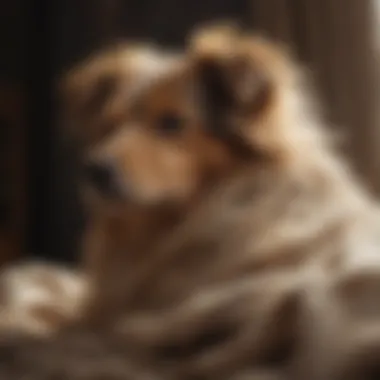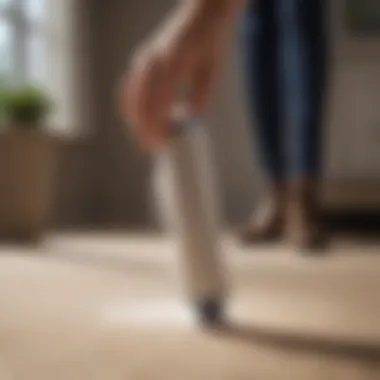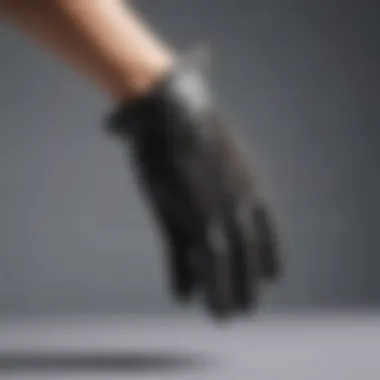Effective Techniques for Removing Dog Hair from Clothing


Intro
Removing dog hair from clothing is a challenge many pet owners face. A dog’s shedding can feel relentless, making it hard to keep clothes hair-free. This article offers practical techniques to remove dog hair effectively, revealing why it attaches to fabrics and how to maintain a cleaner wardrobe.
Understanding the Problem
Dog hair clings to clothing due to static electricity and the structure of pet fur. The fibers of certain fabrics, especially wool and fleece, create an environment for dog hair to latch on. Understanding these factors is key to effective removal. By identifying the types of fabrics that attract dog hair, pet owners can choose their wardrobe with these considerations in mind.
This guide delves into both preventive strategies and removal techniques, ranging from household items to specialized tools. It aims to assist homeowners and renters in keeping their homes and wardrobes clean and inviting, regardless of their furry companions.
Why It Matters
For many, dogs are more than just pets; they are family members. However, the presence of hair on clothing can lead to embarrassment, especially in social situations. Furthermore, allergic reactions to pet dander can adversely affect some individuals. Thus, effectively managing dog hair is not just about aesthetics; it has health implications too.
The following sections will explore a variety of solutions, helping to foster a more harmonious living environment for both pet owners and their guests.
Understanding the Challenge of Dog Hair
Dog hair is a persistent problem for many pet owners. The unavoidable presence of pet hair on clothes is not just cosmetic; it can affect comfort and cleanliness. Recognizing the impact of dog hair in daily life is crucial. Understanding why it sticks to fabric and the nature of dog hair helps in exploring appropriate solutions.
Nature of Dog Hair
Dog hair, unlike human hair, has unique characteristics. It varies in texture, length, and thickness based on breed. Some dogs shed more than others, making the issue more pronounced. Typically, dog hair is soft and lightweight, which can make it cling to clothing fibers. Moreover, it may contain allergens, making good hygiene even more necessary.
When a pet sheds, the hair falls out in clumps, and these can easily embed into various materials. This poses an ongoing challenge to keeping a clean wardrobe.
Why Dog Hair Sticks to Clothes
Several factors contribute to why dog hair easily sticks onto clothing. The first factor is static electricity. This effect is especially noticeable in dry conditions, where clothes tend to attract pet hair. Additionally, the fabric type makes a significant difference. Materials like fleece or wool tend to trap hair more than smoother fabrics like cotton or polyester.
Moreover, when dogs rub themselves against furniture or sit close to their owners, loose hair gets transferred. It is not uncommon to find hair on clothes simply from regular interaction.
"Understanding the characteristics of dog hair and its adhesive properties on clothing can lead to better management strategies."
By examining the nature of dog hair and its capacity to adhere to fabrics, one can better address the challenges posed by pet ownership.
Preventive Measures to Minimize Dog Hair on Clothes
Dog hair on clothing is frustrating. However, taking steps to prevent this issue is essential. Preventive measures can reduce the amount of hair that finds its way onto your garments. This not only saves you time but also maintains the appearance of your wardrobe. A proactive approach allows pet owners to enjoy their furry companions without constant worry about clean clothes.
Choosing the Right Fabrics
Selecting the right types of fabrics is a significant aspect when considering dog hair. Certain materials are more resistant to hair clinging than others. For instance, smooth fabrics like polyester or silk tend to reject pet hair better than textured materials like wool or velvet.
When shopping for clothes, look for blended fabrics that incorporate synthetic fibers. These fibers create a slick surface, making it more difficult for dog hair to adhere. Investing in a wardrobe with practical fabric choices can save you from constant cleaning efforts.
- Best Fabrics: Polyester, nylon, and certain blends.
- Worst Fabrics: Wool, velvet, and other textured materials.
Grooming Your Dog Regularly
Regular grooming is essential for minimizing dog hair shedding. When dogs are groomed, loose hair is removed before it can end up on your clothes. Brushing your dog weekly helps significantly in reducing the amount of hair they lose around the house and on your clothes.


Consider using specialty brushes designed for your dog’s coat type. The right brush can more effectively remove undercoat hair and reduce overall shedding. Along with brushing, regular baths can also help. Bathing your dog removes dead hair and dander, contributing to a cleaner environment.
- Grooming Tips:
- Brush your dog at least once a week.
- Use shedding tools if needed.
- Bathing helps reduce loose hair.
Creating Pet-Free Zones
Establishing specific areas in your home that are off-limits to your pets can greatly reduce the amount of dog hair accumulating on your clothes. Designate rooms or spaces, such as bedrooms or home offices, as pet-free zones. This limits the areas where dog hair can accumulate, thus protecting your clothing.
When pets are not allowed in these areas, you create a cleaner environment for special occasions or moments when you do not want pet hair to interfere. You may also consider providing comfortable spots for them to relax in other parts of your home. This way, pets stay happy while you maintain a level of control over hair presence.
"Preventive measures are always better than having to deal with hair removal later."
Initial Removal Techniques
The battle against dog hair on clothing begins with initial removal techniques. These methods are essential not only for immediate relief but also for preparing garments for deeper cleaning processes. Quick fixes can save you time and effort, especially when you're in a rush. By addressing the issue right away, you can prevent dog hair from embedding itself further into the fabric, making it harder to remove later. The effectiveness of these practices often hinges on the tools and methods selected, which can greatly influence the outcome.
Using a Lint Roller
A lint roller is a valuable tool in the fight against dog hair on clothing. It consists of a handle and a roll of sticky paper that easily picks up hair and lint. The simplicity of its design makes it easy to use. Just roll it over the affected area, and the hair adheres to the sticky surface. To achieve the best results, apply firm pressure while rolling, as this helps lift more hair from the fabric.
Consider maintaining a lint roller close by, whether in your home, car, or office. This portability will allow you to tackle sudden hair emergencies efficiently. Lint rollers are especially useful for removing hair from upholstery or pet beds too.
Using Tape as a Quick Fix
When a lint roller isn't at hand, tape can serve as an excellent substitute. Any type of adhesive tape, from masking tape to duct tape, can be utilized to lift hair from clothes. Simply cut a length of tape, press it against the fabric, and peel it off to see the hair stick to the tape. This method is fast and effective, making it a great option for urgent situations.
Tear off a strip long enough to cover a good area and roll it over the fabric for greater efficiency. It is advisable to be gentle, as overly aggressive pulling can cause damage to certain materials. Keep in mind that tape can leave residue on some fabrics, so always test on a discreet area first.
Using Rubber Gloves to Gather Hair
Rubber gloves can also be an effective tool for gathering dog hair from clothes. When dry, the surface of rubber creates static, attracting hair particles. To utilize this method, simply put on a pair of rubber gloves and wipe your hands across the fabric. The hair will cling to the gloves, allowing you to gather it easily.
This technique works well on various surfaces, and you can rinse off the collected hair under running water, making it a practical choice for those dealing with multiple cleaning tasks. Additionally, using rubber gloves has the added benefit of being eco-friendly compared to disposable options.
In summary, initial removal techniques are crucial for managing dog hair on clothing. Whether using a lint roller, tape, or rubber gloves, these methods provide effective solutions to keep your clothes looking clean and tidy. They serve as the first line of defense, allowing you to maintain a pet-friendly wardrobe with minimal effort.
"Effective removal techniques can drastically reduce the amount of hair that sticks to your clothes, making laundry day less of a chore."
By incorporating these methods into your routine, you will find that managing dog hair becomes more manageable.
Washing Strategies for Clothes
Washing is a crucial element in the battle against dog hair on clothing. The washing process not only removes visible hairs but also reduces allergens and odors associated with pets. A strategic approach to laundry can significantly enhance the effectiveness of hair removal, allowing pet owners to enjoy a cleaner and fresher wardrobe. In this section, we will explore specific elements, benefits, and considerations to help optimize washing strategies against dog hair.
Pre-Wash Preparation Techniques
Pre-wash preparation is essential for maximizing the impact of your wash cycle. Before placing clothes in the washer, consider the following techniques:
- Shake Out Clothing: Before washing, give each item a good shake to dislodge any loose hair. This simple action can make a noticeable difference.
- Use a Lint Brush: A lint brush is effective for gathering pet hair from fabric surfaces. Quickly run it across your clothes to remove larger clumps before washing.
- Consider a Pre-Wash Cycle: Many modern washing machines offer a pre-wash option. This cycle can help loosen and remove hair before the main wash.


Implementing these pre-wash techniques lays the groundwork for a more effective washing process, ensuring the garments come out cleaner.
Choosing the Right Detergent
Selecting the appropriate detergent is also a vital component in effective hair removal. Not all detergents are equally effective against pet hair. Here are key considerations when choosing a detergent:
- Pet Hair Specific Formulas: Some brands offer specially formulated detergents designed to handle pet hair and dander. These products often contain ingredients that help lift hair from fabrics.
- High-Efficiency Detergents: If you have a high-efficiency washer, opt for a compatible detergent. These detergents create fewer suds while remaining effective at removing hair and dirt.
- Cold Water Functionality: Certain detergents are effective in cold water. This is beneficial for preserving color and fabric integrity while keeping washing energy-efficient.
Selecting the right detergent can dramatically improve the effectiveness of your laundry in the context of dog hair removal.
Using a Dryer to Reduce Pet Hair
The drying process can further aid in combating dog hair on clothes, particularly when done properly. Using a dryer for this purpose involves several key points:
- Initial Drying Cycle: Prior to washing, run your clothes in the dryer on a no-heat cycle for about 10 to 15 minutes. This loosens hair from the fabric and collects it in the dryer lint trap.
- Dryer Balls: Consider using dryer balls during the drying process. They help agitate fabrics, which can encourage hair to become dislodged.
- Regular Lint Trap Maintenance: Always clean the lint trap before and after drying. This prevents hair from redepositing back onto clothes during the drying cycle.
Using the dryer as a tool can be quite advantageous. It not only helps reduce pet hair but also speeds up the drying time in a more efficient manner.
Adopting these washing strategies can transform how dog owners manage pet hair on clothing. By combining pre-wash techniques, informed detergent choices, and thoughtful use of the dryer, significant reductions in stubborn pet hair can be achieved.
Post-Wash Techniques for Further Removal
After washing clothes, it is often necessary to take additional steps to ensure that any remaining dog hair is effectively removed. Dog hair can be stubborn, even after a cycle in the dryer or washing machine. Hence, employing post-wash techniques can greatly improve the cleanliness of your garments and maintain a pet-friendly wardrobe. Through specific methods, you can achieve a cleaner and more presentable look without compromising the fabric quality of your clothing.
Air Drying vs. Machine Drying
Deciding between air drying and machine drying can influence how well pet hair is removed from clothing. Air drying is gentler on fabrics and eliminates the risk of shrinkage or damage from high heat settings. However, this method may not be as effective in removing hair when compared to machine drying. The agitation provided by the dryer can dislodge hair particles.
Consider your fabric type when making this decision. Certain delicate fabrics may require air drying to prevent damage, while more durable items can benefit from the dryer.
This comparison highlights the importance of assessing the situation. For optimal results, one might consider using machine drying for tougher fabrics, then follow up with a few additional steps. For lighter fabrics, air drying with subsequent techniques may provide a good balance between protecting your clothing and removing stubborn hair.
Using a Dryer Ball During Drying
Utilizing a dryer ball is an effective method during the drying process to further assist in removing dog hair. Dryer balls, which can be made from materials like wool or plastic, help facilitate the movement of fabrics inside the dryer. This increased movement allows for better agitation, which aids in loosening pet hair and pushing it into the lint trap.
When using dryer balls, it’s essential to consider a few points:
- Choose the right type of dryer ball: Wool dryer balls are typically more effective for this purpose, as they absorb moisture and create friction.
- Use in combination with sheets: Adding dryer sheets can also enhance the static attraction in the dryer, helping to capture hair more effectively. However, be aware that some fabrics may have a negative reaction to certain dryer sheets.
- Regular maintenance of lint traps: Always ensure that your lint trap is clean, as a clogged trap can significantly reduce the drying effectiveness.
By integrating a dryer ball into your laundry routine, you not only improve hair removal but also potentially reduce drying time and fabric softening effects. This small adjustment can make a noticeable difference in your overall laundry results.
Long-Term Solutions for Managing Dog Hair
Managing dog hair effectively requires a long-term strategy that incorporates both preventative measures and proactive cleaning habits. The unceasing shedding of dog fur can be frustrating for pet owners, as it tends to accumulate on clothing, furniture, and various surfaces in the home. By implementing long-term solutions, you can significantly reduce the hassle of dealing with dog hair, leading to a cleaner environment and an improved quality of life for both you and your pet.
Long-term solutions focus primarily on establishing routines and investing in tools that facilitate the removal of dog hair. This approach is not merely about dealing with the consequences of shedding; it's about understanding the cycle and making strategic decisions to mitigate its impact. Furthermore, a well-maintained cleaning routine can save time and effort, contributing positively to your daily life.
Investing in High-Quality Pet Hair Removal Tools
Selecting the right tools plays a key role in efficiently managing dog hair. High-quality pet hair removal tools can make a substantial difference in your cleaning efforts. Here are a few options worth considering:


- Lint Rollers: These are great for quick touch-ups on fabrics. They are easy to carry, making them a convenient choice for traveling or on-the-go.
- Vacuum Cleaners with Pet Hair Attachments: A vacuum specifically designed for pet hair can save you time. Look for models with strong suction and specialized attachments.
- Pet Hair Brushes: Frequent brushing of your dog with a suitable brush minimizes loose hair, so a good pet hair brush can serve two purposes: fur removal from your pet and easy collection of fur in the house.
Investing in these tools might require an initial cost, but their efficiency pays off in the long run. The right tools enable you to manage hair without feeling overwhelmed by the volume your pet sheds.
Establishing a Regular Cleaning Routine
A cleaning routine is integral to effectively managing dog hair in your living space. Consistency in cleaning helps prevent the accumulation of hair and allows you to maintain a tidy home effortlessly. Here are some considerations for establishing a successful routine:
- Scheduled Cleaning Days: Set aside specific days for vacuuming, lint rolling, and dusting. Committing to a routine reduces the burden of cleaning as it becomes a habit.
- Daily Quick Fixes: Incorporate small actions into your day. For example, use a lint roller on clothes as you get dressed or brush your dog after they come inside.
- Decluttering Regularly: Minimizing items in your home can help reduce dog hair collection points. Fewer surfaces mean less hair to manage.
A routine ensures that the cleaning process does not feel overwhelming and can free up more time for leisure and enjoyment with your pet.
By investing in quality tools and establishing a regular cleaning routine, you can create a system that continuously manages dog hair. This not only maintains cleanliness but also contributes to a more pleasant living environment for everyone in the household.
Choosing the Right Cleaning Products
Selecting appropriate cleaning products is crucial when dealing with stubborn dog hair on clothing. The right products not only enhance the efficiency of hair removal but also protect the integrity of your fabrics while providing a clean environment. There are many options available on the market, but understanding their features is key to making informed choices.
Key elements to consider include:
- Effectiveness: You want products that are designed specifically for pet hair removal. Many commercial options contain adhesive surfaces or unique formulas that can significantly ease the burden of hair removal.
- Fabric Compatibility: Not all cleaning products are suitable for all fabric types. It's important to read labels carefully to avoid damaging delicate materials.
- Safety: Look for cleaning solutions that are safe for pets and humans. Some commercial products include chemicals that may cause allergic reactions or harm furry friends.
Investing in the right cleaning tools and products can lead to remarkable improvements in maintaining clothing cleanliness and prolonging the life of your garments.
Evaluating Commercial Pet Hair Removers
When it comes to commercial pet hair removers, a thorough evaluation is necessary. Different products have varying forms and effectiveness. Lint rollers are a popular choice, often featuring sticky sheets that can easily lift hair off clothing. Another common option is pet hair removal brushes, which utilize specialized bristles to effectively gather and remove hairs without excessive effort.
Here are a few considerations when choosing a commercial pet hair remover:
- Price: While higher-priced items may offer better longevity or effectiveness, it is vital to assess regular reviews and user experiences to ensure value for money.
- User Reviews: Always check online reviews on platforms like Reddit or product-focused forums. Insights from other pet owners can guide you toward reliable options.
- Variety of Uses: Look for products that offer versatility. Some can work on furniture and carpets, as well as clothing. This multipurpose function can save money and storage space.
Home Remedies for Dog Hair Removal
If you prefer natural solutions or want to avoid commercial products, several home remedies can effectively remove dog hair from clothing. These methods often utilize common household items that can be just as efficient.
A few notable home remedies include:
- Rubber Gloves: Wearing slightly damp rubber gloves creates static electricity that attracts dog hair. Simply run your hand over the fabric, and watch the hair come off seamlessly.
- Vinegar in the Wash: Adding half a cup of white vinegar to your wash cycle can decrease static and help release hair from fabrics.
- Balloon Trick: Rubbing a balloon atop clothing can also create static that lifts hair away. This is a simple and effective method that is great for quick fixes.
Using these remedies, pet owners can maintain a hair-free wardrobe effectively, all while avoiding additional purchases. The adaptability of home solutions contributes to overall fabric care and cleanliness.
Closure
In concluding this article, it is essential to recognize the significance of adopting effective strategies for removing dog hair from clothing. The persistent presence of pet hair can be not just an aesthetic bother but also a source of discomfort for those affected by allergies. Thus, addressing this issue holds practical implications for maintaining a clean and comfortable living environment.
Recap of Effective Strategies
Throughout the article, various techniques have been outlined to combat dog hair effectively. Key strategies include:
- Preventive Measures: Choosing appropriate fabrics, regular dog grooming, and creating pet-free zones are foundational steps to reduce the amount of hair that clings to clothes.
- Initial Removal Techniques: Utilizing simple tools like lint rollers, tape, and rubber gloves can provide immediate relief and be very effective in gathering loose hair from clothing.
- Washing Strategies: Pre-wash preparations, selecting proper detergents, and making use of the dryer can significantly minimize dog hair on clothing.
- Post-Wash Techniques: Choosing to air dry or using dryer balls can enhance the removal of residual pet hair after washing.
- Long-Term Solutions: Investing in specialized pet hair removal tools and establishing a routine cleaning process can ensure ongoing management of hair issues.
- Cleaning Products: Evaluating both commercial solutions and home remedies can further enhance effectiveness in removing stubborn hair.
Encouragement to Create a Dog Hair Management Routine
Creating a consistent dog hair management routine is paramount for anyone living with a canine companion. The effort spent on these strategies will pay off in maintaining a cleaner closet and ensuring comfort in daily wear. Establishing time for regular grooming sessions, integrating designated cleaning days, and routinely assessing wardrobe choices will collectively contribute to a more manageable living situation. A commitment to these practices will not only foster a more pleasant home environment but also promote harmony between pet ownership and personal comfort.
Regular attention to dog hair management will aid in preserving the integrity of clothing, thus enhancing overall enjoyment of wardrobe choices.
In summary, effective techniques exist for reducing and removing dog hair from clothing. By combining prevention, immediate removal strategies, and long-term management, dog owners can significantly diminish the presence of pet hair, allowing for a harmonious balance between enjoying the companionship of dogs and maintaining a clean wardrobe.



